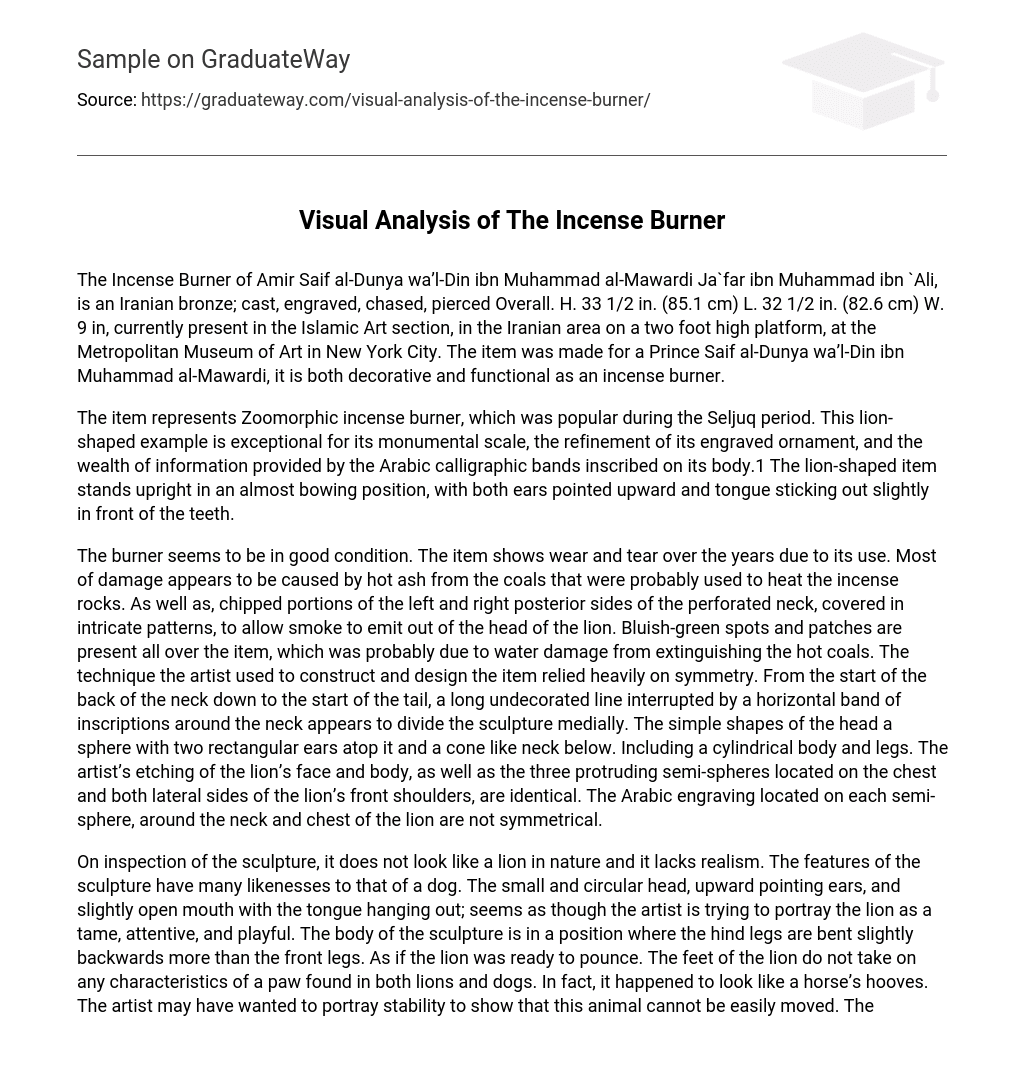The Incense Burner of Amir Saif al-Dunya wa’l-Din ibn Muhammad al-Mawardi Ja`far ibn Muhammad ibn `Ali, is an Iranian bronze; cast, engraved, chased, pierced Overall. H. 33 1/2 in. (85.1 cm) L. 32 1/2 in. (82.6 cm) W. 9 in, currently present in the Islamic Art section, in the Iranian area on a two foot high platform, at the Metropolitan Museum of Art in New York City. The item was made for a Prince Saif al-Dunya wa’l-Din ibn Muhammad al-Mawardi, it is both decorative and functional as an incense burner.
The item represents Zoomorphic incense burner, which was popular during the Seljuq period. This lion-shaped example is exceptional for its monumental scale, the refinement of its engraved ornament, and the wealth of information provided by the Arabic calligraphic bands inscribed on its body.1 The lion-shaped item stands upright in an almost bowing position, with both ears pointed upward and tongue sticking out slightly in front of the teeth.
The burner seems to be in good condition. The item shows wear and tear over the years due to its use. Most of damage appears to be caused by hot ash from the coals that were probably used to heat the incense rocks. As well as, chipped portions of the left and right posterior sides of the perforated neck, covered in intricate patterns, to allow smoke to emit out of the head of the lion. Bluish-green spots and patches are present all over the item, which was probably due to water damage from extinguishing the hot coals. The technique the artist used to construct and design the item relied heavily on symmetry. From the start of the back of the neck down to the start of the tail, a long undecorated line interrupted by a horizontal band of inscriptions around the neck appears to divide the sculpture medially. The simple shapes of the head a sphere with two rectangular ears atop it and a cone like neck below. Including a cylindrical body and legs. The artist’s etching of the lion’s face and body, as well as the three protruding semi-spheres located on the chest and both lateral sides of the lion’s front shoulders, are identical. The Arabic engraving located on each semi-sphere, around the neck and chest of the lion are not symmetrical.
On inspection of the sculpture, it does not look like a lion in nature and it lacks realism. The features of the sculpture have many likenesses to that of a dog. The small and circular head, upward pointing ears, and slightly open mouth with the tongue hanging out; seems as though the artist is trying to portray the lion as a tame, attentive, and playful. The body of the sculpture is in a position where the hind legs are bent slightly backwards more than the front legs. As if the lion was ready to pounce. The feet of the lion do not take on any characteristics of a paw found in both lions and dogs. In fact, it happened to look like a horse’s hooves. The artist may have wanted to portray stability to show that this animal cannot be easily moved. The sculpture also lacks the normal body curves that are present in animals in nature. Such as, curvatures around the shoulders and hind hips. No joints were represented in the sculpture around the knees and hind legs as well. The artist may have wanted to depict this lion as a tamed and domesticated animal who seeks to serve its master, Prince Saif al-Dunya wa’l-Din ibn Muhammad al-Mawardi. Like many leaders and people of royalty, the desire of having such a ferocious leader of the animal kingdom as a servant is common and it represents power over this predator and strength.
A ruler that is meant to be feared. This piece has interested me in researching its origin and purpose. Based on the artist’s portrayal of the lion, questions surrounding the choice of making the lion look like a dog. The cultural significance of such an incense burner at this time period and when this item would be used. How the lion was constructed and what type of tools the artist used at this time. Was the artwork influenced by other cultures through interactions with trading with foreigners or through the artist’s travels? How this piece was discovered and who are its previous owners before it reached the MoMA. Why was the name of the artist prominently displayed on the chest of the lion underneath the Prince’s name? How did the Zoomorphic style come about in Iran as well as more information into the culture and customs of this time period in Iran? Many questions arise when observing this incense burner that could be better answered with further research.





